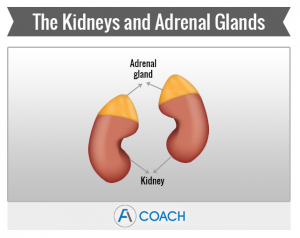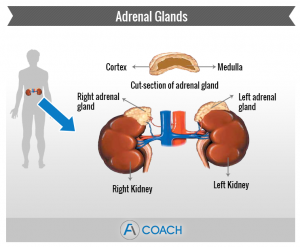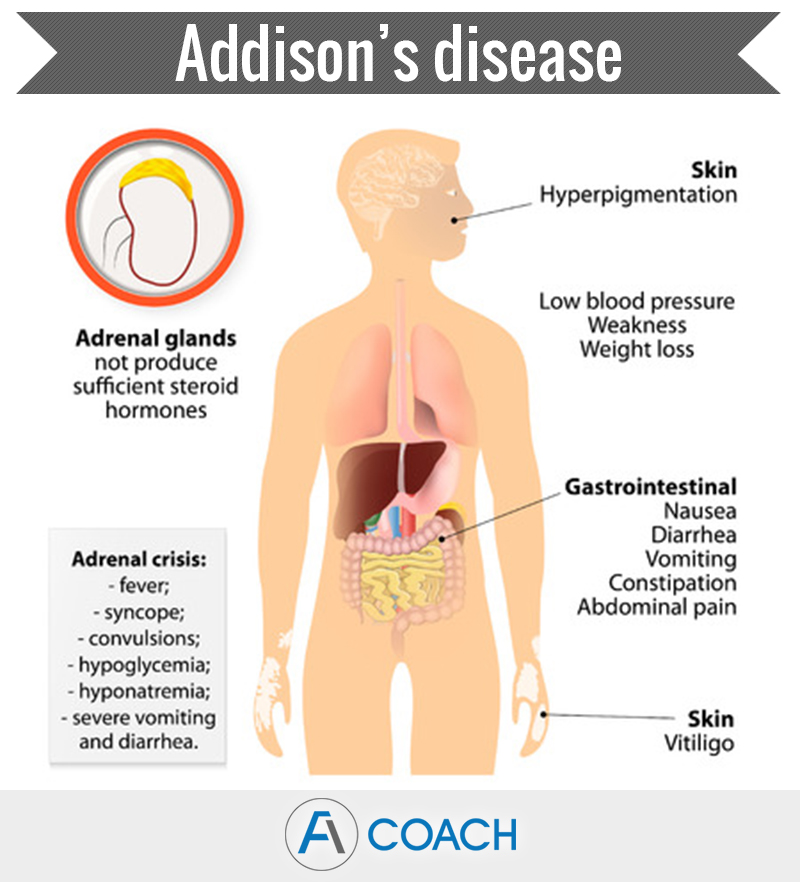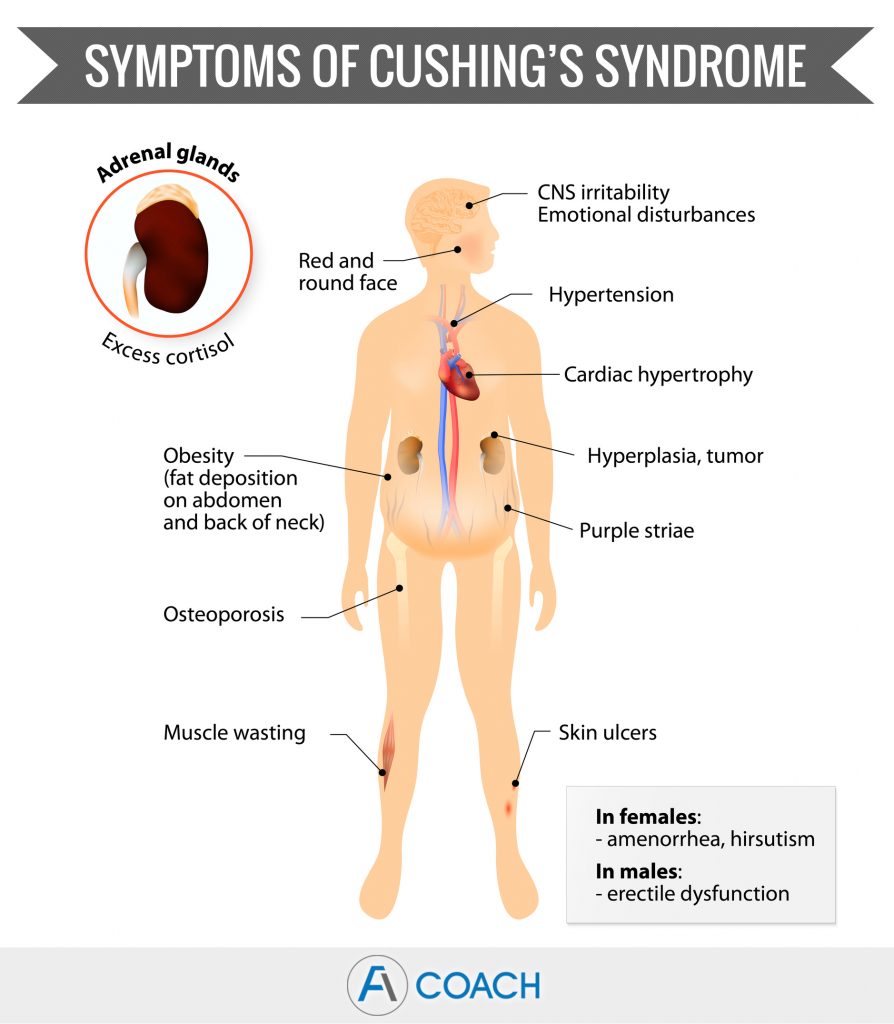December 3rd, 2016 •
Comments Off on Adrenal Gland Disorders: A Quick Overview

Adrenal gland disorders (or diseases) are conditions that disrupt the normal functioning of the adrenal glands. Disorders of the adrenal glands may occur when the adrenal gland itself is affected by genetic mutation, tumors, or infections. But sometimes the cause is a problem in another gland, such as the pituitary, which helps to regulate the adrenal gland. Certain medications can also cause the adrenal glands not to function properly.
When the adrenal glands produce too few or too many hormones, or when too many hormones are introduced by an outside source, significant disorders can develop.
Adrenal gland disorders can be congenital or acquiered:
Congenital: a condition that exist at birth or before birth.
Acquired: a condition that develops over the course of one’s life.
Disorders can be classified into 2 types:
- Either too little hormone is produced
- Or too much hormone is produced
Where are the Adrenal Glands located?
The adrenal glands are two small organs that look like triangles above the kidneys that secrete vital hormones to our body. They are more or less 1.5 inches tall and 3 inches wide. The name directly defines their location in the body, the etymology of adrenal is from two Latin words “ad” and “renes” meaning “near” for ad and “the kidneys” for “renes”.

Adrenal Gland Function
The adrenal glands are responsible for a number of things but when you think of adrenal glands, probably stress might be the first word that comes to your mind. And you are right, the adrenal glands are commonly known for releasing adrenaline, which prepares the body to fight-or-flight in stressful situations. But the adrenal glands not only produce adrenaline, they also produce many other hormones that are necessary for your overall health.
If you take a look at the image below you can see that the adrenal glands consist of two parts: the adrenal cortex and adrenal medulla. The hormones released by the adrenal cortex are necessary for life and those secreted by the adrenal medulla are not.
Adrenal Cortex is the external part of the gland that produces 3 hormones.
- Mineralocorticoids (most importantly aldosterone)
- Glucocorticoids (mainly cortisol)
- Sex hormones (more sex hormones are released by the ovaries or testes)
Cortisol is involved in the stress response, helps regulate blood pressure and body metabolism. Aldosterone helps to maintain the right balance of salt and water and regulate blood pressure. Small amounts of male and female sex hormones are also released by the adrenal cortex.
Adrenal Medulla is the internal part of the gland that produces catecholamines including adrenaline, noradrenaline and small amounts of dopamine. These hormones control your body’s stress response (fight-or-flight response).

Tumors of the Adrenal Gland
A tumor starts when healthy cells change, grow out of control and form a mass. A tumor can either be malignant (cancerous) or benign (non cancerous). A malignant tumor has the ability to grow uncontrollably and spread out to various parts of the body invading surrounding tissue.
A benign tumor is similar to cancer as the growth is caused by abnormal cell growth, but the important difference is that it cannot spread to other parts of the body and it does not affect nearby tissue. The mass stays where it grows. A benign tumor is not dangerous by itself, but the location of the tumor can cause problems. If the tumor puts pressure on a main artery, primary nerve or compresses brain matter even a benign tumor can lead to health issues.
An adrenal gland tumor starts in an adrenal gland, but could also result from a cancer that begins in another organ such as the lungs and travels to the adrenal gland.
Adrenal Adenoma
Adenomas of the adrenal gland are benign (non-cancerous) tumors on the adrenal gland. They arise from the adrenal cortex, the outer layer of the adrenal gland. Most patients with adrenal adenoma do not have any signs or symptoms. But some adenomas can become “functioning”, meaning that they produce steroid hormones, often in excess of what the adrenal glands normally would produce. High levels of these hormones can cause obvious symptoms. Too much aldosterone causes Conn´s syndrome, large amounts of cortisol causes Cushing´s syndrome and too much of male sex steroids causes acne and hair growth. Functioning adrenal adenomas could be treated with surgery and/or medications. (), ().
Adrenocortical Carcinoma
Adrenocortical carcinoma is a rare cancer that affects the outer layer of the adrenal glands (adrenal cortex). Adrenocortical carcinoma can happen at any age but is more likely in children under the age of 5 and in adults in their 40s and 50s. Symptoms may include pain in the abdomen and flank and certain physical changes. A non-functioning adrenocortical tumor may not cause symptoms in the early stages. A functioning tumor on the other hand produces too much of a certain hormone (cortisol, aldosterone, testosterone, or estrogen) and symptoms include, weight gain, high blood pressure, possibly deepening of the voice and frequent urination. Three types of standard treatment can be used, radiation therapy, surgery and chemotherapy. ().
Pheochromocytoma
Pheochromocytomas are rare tumors of adrenal gland tissue. They usually develop in the center of one or both adrenal glands (medulla) and often cause the adrenal glands to make too many stress hormones called epinephrines and norepinephrines. This may lead to high blood pressure and cause symptoms such as rapid heart rate, nausea, irritability, severe headaches, vomiting, weight loss, chest pain, weakness, hand tremor, sleeping difficulty and a feeling of anxiety. Very few pheochromocytomas are cancerous. Treatment involves surgery, but when it cannot be surgically removed, medications can be taken to manage the control effects of excessive hormones. Chemotherapy and radiation therapy have not been effective in curing this kind of tumor(), (), (), ()
Disorders of hormone over/-under Production
Addison’s Disease
Addison’s disease, also knows as primary adrenal insufficiency or hypoadrenalism, is a condition that occurs when the adrenal glands produce insufficient amounts of cortisol and often aldosterone as well. This condition is usually the result of a problem with the immune system in the causing the body to attack the outer layer of the adrenal gland (the adrenal cortex). Tuberculosis, certain medications, sepsis, and bleeding into both adrenal glands are other known causes for Addison’s disease.
Another form of Addison’s disease, secondary adrenal insufficiency is caused by a lack of secretion of a hormone called corticotropin-releasing hormone (CRH) from the hypothalamus, or of adrenocorticotropin-releasing hormone (ACTH) from the pituitary gland.
Some of the symptoms include chronic diarrhea, darkening of the skin, changes in blood pressure, paleness, fatigue, extreme weakness, nausea and vomiting, weight loss. salt craving Treatment involves medication, usually taken by mouth, to replacing the missing hormones. Lifelong replacement therapy is needed, with regular follow-up treatment as well as monitoring for other health issues. ()

Adrenal Crisis
Adrenal crisis (also known as Addisonian crisis and acute adrenal insufficiency) is a potentially life-threatening medical emergency that requires immediate treatment caused by insufficient levels of the hormone cortisol. An adrenal crisis can occur when the adrenal gland is deteriorating (Addison’s disease, primary adrenal insufficiency), or in the case of a pituitary gland injury (secondary adrenal insufficiency), or when adrenal insufficiency is undiagnosed or (not properly) treated. Other risk factors are infection, trauma, surgery (or any form of mental or physical stress), dehydration and abrupt withdrawal of steroid medication. Treatment involves an immediate injection of hydrocortisone (an injectable corticosteroid) and usually supportive treatment of low blood pressure. Hospitalization is needed for adequate treatment and monitoring. ().
Cushing’s Syndrome
Cushing’s syndrome, also known as hypercortisolism, is developed when the body’s tissues are exposed to high levels of cortisol over a longer period of time. Signs and symptoms of Cushing’s syndrome include weight gain, upper body obesity, high blood pressure, backache, muscle weakness, fatigue, acne, , easy bruising and purple stretch marks on the skin. Affected woman may also experience irregular or absent menstrual periods and thicker or more visible growth of body and facial hair (hirsutism). Affected men may experience a decreased libido, erectile dysfunction or decreased fertility. Cushings’s syndrome may be caused by a variety of factors such as long-term use of corticosteroid medications, adrenal adenomas or tumors in the pituitary gland. Treatment depends on the underlying cause, but may include surgery to remove tumors or lowering the dosage of corticosteroids ().

Adrenal Gland Suppression
When people take steroid medication such as hydrocortisone, prednisone or dexamethasone the normal activity of the adrenal glands can be suppressed (). These medicines act like cortisol in the body and the brain isn´t able to distinguish between the naturally produced steroid and the medication. As a result, when you use steroid medications for a month or longer, the brain thinks it doesn’t need as much cortisol and the adrenal glands begin to produce much less than usual. In some cases, they may even stop producing the hormone altogether.
Typically the adrenal glands do bounce back and start producing normal amounts of hormones if the dose of steroids is tapered slowly before the drug is stopped completely. But when steroid medication is suddenly stopped after being taken for several weeks or more an adrenal crisis can be triggered.
Confusion Between Addison’s Disease And Adrenal Fatigue
Adrenal Fatigue and severe adrenal insufficiency (or Addison’s disease) seem to be highly related and this is usually cause for a lot of confusion. But Addison’s disease is more of a total shutdown of the adrenal glands, whereas Adrenal Fatigue occurs when the adrenal glands are unable to secrete adequate hormones. It is a milder (temporary) version of Addison’s disease if you will.
Additionally, Addison’s disease has a clearly defined symptoms and there are lab tests for diagnosis that include blood levels of cortisol and urinary levels of cortisol and aldosterone. Adrenal Fatigue on the other hand cannot be tested (outside alternative testing) and is manifested through vague symptoms that could also signify other disorders.
3 other key differences are:
- Addison’s disease is a lifelong condition that requires continuous treatment with steroid replacement therapy. Adrenal Fatigue can often be naturally corrected (sometimes bio-identical hormone therapy is used).
- Addison’s disease occurs when the adrenal glands are damaged, while Adrenal Fatigue usually develops as a result of overworking and depleting the adrenal glands. If the causes are removed, the adrenal glands will recover.
- Unlike Addison’s disease, for which the estimated prevalence is 1 in 20,000 persons in the United States and Western Europe, Adrenal Fatigue is very very common today. Dr. James Wilson estimates that it now affects millions of people around the world.
References & Further Reading
















